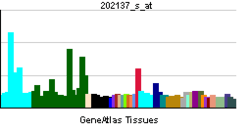ZMYND11
Zinc finger MYND domain-containing protein 11 is a protein that in humans is encoded by the ZMYND11 gene.[1][2][3]
Function
The protein encoded by this gene was first identified by its ability to bind the adenovirus E1A protein. The protein localizes to the nucleus. It functions as a transcriptional repressor, and expression of E1A inhibits this repression. Alternatively spliced transcript variants encoding different isoforms have been identified.[3]
Interactions
ZMYND11 has been shown to interact with:
References
- ↑ Hateboer G, Gennissen A, Ramos YF, Kerkhoven RM, Sonntag-Buck V, Stunnenberg HG et al. (Jul 1995). "BS69, a novel adenovirus E1A-associated protein that inhibits E1A transactivation". The EMBO Journal 14 (13): 3159–69. PMC 394377. PMID 7621829.
- ↑ Masselink H, Bernards R (Mar 2000). "The adenovirus E1A binding protein BS69 is a corepressor of transcription through recruitment of N-CoR". Oncogene 19 (12): 1538–46. doi:10.1038/sj.onc.1203421. PMID 10734313.
- ↑ 3.0 3.1 "Entrez Gene: ZMYND11 zinc finger, MYND domain containing 11".
- ↑ 4.0 4.1 Kurozumi K, Nishita M, Yamaguchi K, Fujita T, Ueno N, Shibuya H (Apr 1998). "BRAM1, a BMP receptor-associated molecule involved in BMP signalling". Genes to Cells 3 (4): 257–64. doi:10.1046/j.1365-2443.1998.00186.x. PMID 9663660.
- ↑ Hughes-Davies L, Huntsman D, Ruas M, Fuks F, Bye J, Chin SF et al. (Nov 2003). "EMSY links the BRCA2 pathway to sporadic breast and ovarian cancer". Cell 115 (5): 523–35. doi:10.1016/s0092-8674(03)00930-9. PMID 14651845.
- ↑ Wei G, Schaffner AE, Baker KM, Mansky KC, Ostrowski MC. "Ets-2 interacts with co-repressor BS69 to repress target gene expression". Anticancer Research 23 (3A): 2173–8. PMID 12894593.
Further reading
- Bonaldo MF, Lennon G, Soares MB (Sep 1996). "Normalization and subtraction: two approaches to facilitate gene discovery". Genome Research 6 (9): 791–806. doi:10.1101/gr.6.9.791. PMID 8889548.
- Kurozumi K, Nishita M, Yamaguchi K, Fujita T, Ueno N, Shibuya H (Apr 1998). "BRAM1, a BMP receptor-associated molecule involved in BMP signalling". Genes to Cells 3 (4): 257–64. doi:10.1046/j.1365-2443.1998.00186.x. PMID 9663660.
- Lo KW, Naisbitt S, Fan JS, Sheng M, Zhang M (Apr 2001). "The 8-kDa dynein light chain binds to its targets via a conserved (K/R)XTQT motif". The Journal of Biological Chemistry 276 (17): 14059–66. doi:10.1074/jbc.M010320200. PMID 11148209.
- Ansieau S, Leutz A (Feb 2002). "The conserved Mynd domain of BS69 binds cellular and oncoviral proteins through a common PXLXP motif". The Journal of Biological Chemistry 277 (7): 4906–10. doi:10.1074/jbc.M110078200. PMID 11733528.
- Wei G, Schaffner AE, Baker KM, Mansky KC, Ostrowski MC (2003). "Ets-2 interacts with co-repressor BS69 to repress target gene expression". Anticancer Research 23 (3A): 2173–8. PMID 12894593.
- Hughes-Davies L, Huntsman D, Ruas M, Fuks F, Bye J, Chin SF et al. (Nov 2003). "EMSY links the BRCA2 pathway to sporadic breast and ovarian cancer". Cell 115 (5): 523–35. doi:10.1016/S0092-8674(03)00930-9. PMID 14651845.
- Colland F, Jacq X, Trouplin V, Mougin C, Groizeleau C, Hamburger A et al. (Jul 2004). "Functional proteomics mapping of a human signaling pathway". Genome Research 14 (7): 1324–32. doi:10.1101/gr.2334104. PMC 442148. PMID 15231748.
- Rual JF, Venkatesan K, Hao T, Hirozane-Kishikawa T, Dricot A, Li N et al. (Oct 2005). "Towards a proteome-scale map of the human protein-protein interaction network". Nature 437 (7062): 1173–8. doi:10.1038/nature04209. PMID 16189514.
- Isobe T, Uchida C, Hattori T, Kitagawa K, Oda T, Kitagawa M (Jan 2006). "Ubiquitin-dependent degradation of adenovirus E1A protein is inhibited by BS69". Biochemical and Biophysical Research Communications 339 (1): 367–74. doi:10.1016/j.bbrc.2005.11.028. PMID 16300738.
- Wan J, Zhang W, Wu L, Bai T, Zhang M, Lo KW et al. (Jan 2006). "BS69, a specific adaptor in the latent membrane protein 1-mediated c-Jun N-terminal kinase pathway". Molecular and Cellular Biology 26 (2): 448–56. doi:10.1128/MCB.26.2.448-456.2006. PMC 1346911. PMID 16382137.
- Velasco G, Grkovic S, Ansieau S (Jun 2006). "New insights into BS69 functions". The Journal of Biological Chemistry 281 (24): 16546–50. doi:10.1074/jbc.M600573200. PMID 16565076.

